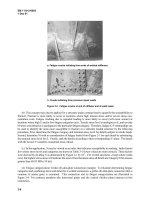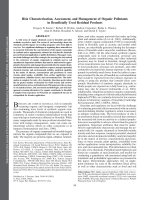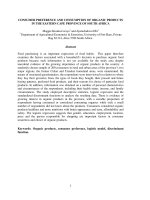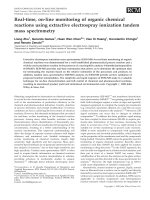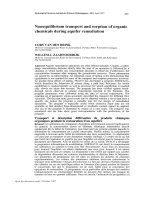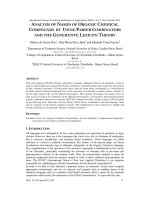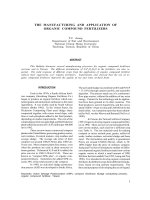EVALUATION AND ASSESSMENT OF ORGANIC CHEMICAL REMOVAL TECHNOLOGIES FOR NEW JERSEY DRINKING WATER GROUND WATER REPORT pptx
Bạn đang xem bản rút gọn của tài liệu. Xem và tải ngay bản đầy đủ của tài liệu tại đây (405.01 KB, 93 trang )
and
EVALUATION AND ASSESSMENT
OF
ORGANIC CHEMICAL REMOVAL TECHNOLOGIES
FOR
NEW JERSEY DRINKING WATER
GROUND WATER REPORT
January 2007
i
TABLE OF CONTENTS
CHAPTER 1 - INTRODUCTION…………………………………………………………… … 1
BACKGROUND…………………………………………………………………………. 1
PURPOSE AND SCOPE…………………………………………………………………. 2
LITERATURE REVIEW……………………………………………………… ……… 2
CHAPTER 2 – OCCURRENCE OF UOCs IN NJ GROUND WATERS…… ……………… 4
NJDEP STUDIES…………………….………………………………………………… 4
ORGANIC CHEMICALS DETECTED IN NJ GROUND WATERS.………………… 5
CATEGORIZATION OF DETECTED UOCs…………………………………………… 7
CHAPTER 3 – AVAILABLE TREATMENT TECHNIQUES.…………………………………. 10
INTRODUCTION………………………………………………………………………… 10
ADSORPTION PROCESSES…………………………………………………………… 11
General Process Description…….………………………………………………… 11
Factors Affecting Process Efficiency……….…………………………………… 12
Applicability to UOC Removal……………………………………………………. 12
OXIDATION PROCESSES……………………………………………………………… 14
General Process Description………………………………………………………. 14
Factors Affecting Process Efficiency……………………………………………… 16
Applicability to UOC Removal……………………………………………………. 17
AIR STRIPPING PROCESSES…………………………………………………………… 19
General Process Description………………………………………………………. 19
Factors Affecting Process Efficiency……………………………………………… 19
Applicability to UOC Removal……………………………………………………. 20
MEMBRANE PROCESSES………………………………………………………………. 22
General Process Description………………………………………………………. 22
Factors Affecting Process Efficiency……………………………………………… 24
Applicability to UOC Removal……………………………………………………. 25
BIOLOGICAL PROCESSES……………………………………………………………… 26
General Process Description………………………………………………………. 26
Factors Affecting Process Efficiency……………………………………………… 26
Applicability to UOC Removal……………………………………………………. 27
SUMMARY OF AVAILABLE TREATMENT TECHNIQUES…………………………. 27
CHAPTER 4 – APPLICABLE TECHNOLOGIES FOR NJ……………………………………… 33
INTRODUCTION………………………………………………………………………… 33
ACTIVATED CARBON ADSORPTION………………………………………………… 33
General…………………………………………………………………………… 33
Process Description……………………………………………………………… 34
Operational/Regulatory Considerations…………………………………………… 36
Estimated Costs……………………………………………………………………. 38
AIR STRIPPING………………………………………………………………………… 39
General……………………………………………………………………………. 39
Process Description………………………………………………………………. 39
Operational/Regulatory Considerations………………………………………… 42
Estimated Costs…………………………………………………………………… 43
ii
OXIDATION PROCESSES…………………………………………………………… 45
General… ………………………………………………………………………… 45
Process Description……………………………………………………………… 45
Operational/Regulatory Considerations…………………………………………… 48
Estimated Costs……………………………………………………………………. 48
COMBINATIONS OF PROCESSES AND SUMMARY………………………………… 51
SUMMARY OF APPLICABLE TREATMENT TECHNIQUES………………………… 52
CHAPTER 5 - SUMMARY OF FINDINGS AND CONCLUSIONS……………………………. 53
BACKGROUND………………………………………………………………………… 53
FINDINGS………………………………………………………………………………… 54
CONCLUSIONS………………………………………………………………………… 55
FURTHER RESEARCH………………………………………………………………… 57
POTENTIAL FUNDING………………………………………………………………… 57
APPENDIX A REFERENCES…………………………………………………………………… 59
APPENDIX B LIST OF ORGANIC CHEMICALS FOUND IN NJ GROUND WATERS…… 63
APPENDIX C TREATABILITY OF ORGANIC CHEMICALS FOUND IN
NJ GROUND WATERS…………………………………………………… 79
List of Tables
Table 2-1 Number of Times TICs found in Raw Water Samples Only (21 System Studied) 6
Table 2-2 Classes and Categories of UOCs Detected………………………………….……. 9
Table 3-1 General Description of Membrane Systems Commonly Used in
Water Treatment…………………………………………………………… 23
Table 3-2 Unit Processes and Operations Used for EDCs ad PPCPs Removal……………… 29
Table 3-3 Treatability of Cyclics…………………………………………………………… 30
Table 3-4 Treatability of Aliphatics…………………………………………………………. 31
Table 3-5 Treatability of Aromatics…………………………………………………………. 32
Table B-1 Aliphatic Found in NJ Ground Waters………………………………………….… 64
Table B-2 Cyclics Found in NJ Ground Waters……………………………………………… 68
Table B-3 Aromatics Found in NJ Ground Waters………………………………………… 71
Table C-1 Cyclics Found in NJ Ground Waters……………………………………………… 80
Table C-2 Aliphatic Found in NJ Ground Water…………………………………………… 82
Table C-3 Aromatics Found in NJ Ground Water…………………………………………… 85
List of Figures
Figure 3-1 Volatility of Classes of Organic Chemicals………………………………….…… 21
Figure 3-2 Henry’s Law Coefficients for Various Organic Chemicals………………………. 22
1
1
CHAPTER 1 - INTRODUCTION
BACKGROUND
Numerous organic chemicals are used every day in New Jersey (NJ) for industrial, commercial and
household purposes. A number of these chemicals have found their way into the State’s wastewater
treatment facilities, receiving waters, aquifers and drinking water treatment facilities. This situation
is not unique to NJ as occurrence studies conducted around the country indicate similar findings. A
recent report (dated December 20, 2005) completed by the Environmental Working Group (a
nonprofit organization based in Washington, DC) indicated that 141 unregulated organic chemicals
(UOCs) were detected in tap waters from 42 states.
The various types of UOCs that have been detected include:
• Pesticides
• Volatile organic chemicals (VOCs)
• Endocrine-disrupting compounds (EDCs)
• Pharmaceuticals and personal care products (PPCPs)
• Petroleum-related compounds
• Other industrial organic chemicals
Also, some naturally-occurring organic chemicals have been detected.
State and Federal agencies, environmental groups and the public are raising concerns regarding these
chemicals as emerging contaminants of interest even though many of the chemicals have only been
found at trace concentrations and only sparse data are available regarding their health and/or
environmental effects. The fact that organic chemicals are being detected in drinking water supplies
and that there is a concern regarding their health effects raises a fundamental question – what are the
best available treatment technologies for removing these organic chemicals from drinking water
supplies? And more specific to NJ, which technologies are most applicable to the State’s ground
water systems, and to what level should these compounds be removed? As answers to these
questions are developed, it should be noted that the ability to detect these compounds is simply a
function of the analytical method, and that removal efficiency is, in reality, a reflection of the
2
2
detection limits. Verification of complete removal of the compounds is not possible; one can simply
document that concentrations are below the detection limits of the current analytical methods.
The New Jersey Department of Environmental Protection (NJDEP), in conjunction with the
Drinking Water Quality Institute (DWQI), is considering potential options for addressing these
contaminants in NJ drinking waters, and is seeking information on the effectiveness of various
treatment technologies to assist in their evaluations. Treatability data are available for some of the
organic chemicals that have been detected, but very little to no information on treatment removal
efficiencies at the low UOC concentrations present in ground water is available for the vast majority
of the chemicals.
PURPOSE AND SCOPE
This project is designed to review and summarize existing information on the effectiveness of
various treatment technologies for removing UOCs and to identify the best available technologies
for removing the organic chemicals found in NJ drinking waters. This report specifically addresses
organic chemicals detected in ground waters in the State. For the purpose of this report, the synthetic
organic chemicals are referred to as UOCs. It should be noted that the scope of this study does not
include disinfection by-products or the “common” volatile organic chemicals that have been detected
in ground waters. An extensive literature review was completed to document existing information
on the removal of organic chemicals from drinking water. The available treatment techniques were
reviewed and summarized to determine the most applicable technologies for NJ ground water
supplies. The most applicable technologies are described relative to performance, reliability,
treatment issues, and approximate (or relative) costs. The results of this project will be used by
NJDEP to determine the need for and extent of demonstration testing that may be conducted to
further evaluate the most feasible technologies as they apply to NJ ground water supplies.
LITERATURE REVIEW
The Project Team conducted a comprehensive literature review to evaluate the state of knowledge of
treatment technologies for removing organic chemicals. Much of the information has been
3
3
assembled from literature searches that Black & Veatch (B&V) and the Project Team members have
performed for several recent American Water Works Association Research Foundation (AwwaRF)
projects and other research projects. Appendix A includes a list of references that have been
developed by the Project Team. A significant amount of information on the removal of EDCs and
PPCPs during water treatment is now available. The following are examples of AwwaRF studies that
have provided important information on the treatment of organic chemicals:
• Project #2897 - Impact of UV and UV - Advanced Oxidation Processes on Toxicity of
Endocrine-Disrupting Compounds in Water
• Project #2902 - Evaluation of Triclosan Reactivity in Chlorinated and
Monochloraminated Waters
• Project #2758 - Evaluation of Conventional and Advanced Treatment Processes to
Remove Endocrine Disruptors and Pharmaceutically Active Compounds
• Pharmaceuticals and Personal Care Products: Occurrence and Fate in Drinking Water
Treatment (2004)
B&V and/or the Project Team members have been involved in these projects.
The literature review has focused on two major areas: (1) identification of treatment processes that
definitively have been reported to definitively remove specific organic chemicals, and (2) relating
the removal of well-studied compounds (e.g., lindane, atrazine, geosmin, inorganic metals and
oxoanions, natural organic matter (NOM) surrogate compounds) by conventional and advanced
processes to the physical and chemical properties of compounds like EDCs and PPCPs, and other
industrial organic chemicals. It should be noted that EDCs are unique in that they are not a list or
type of compound – they are a class of compounds that produce a toxicological effect. Most EDCs
are industrial organic chemicals and PPCPs The review has included emerging organic EDCs and
PPCPs, as well as treatability of other micropollutants where more extensive work has been
conducted, providing a framework for understanding and predicting removal of emerging
compounds. The findings have been utilized from the perspective of identifying trends in treatability
based upon the physical structure of the compounds (molecular size/ polarity/functionality). The
results of the literature review were used to determine which organic chemicals might be removed
by the available treatment techniques as discussed in Chapter 3 - Available Treatment Techniques.
4
4
CHAPTER 2 - OCCURRENCE OF UOCs IN NJ GROUND WATERS
NJDEP STUDIES
In 1997, the NJDEP’s Division of Science, Research and Technology began a multi-year project
funded through the NJ A-280 Safe Drinking Water Research Fund to assess the occurrence of UOCs
in NJ’s ground water supplies (Murphy, 2003). More specifically, this project investigated the
occurrence of Tentatively Identified Compounds (TICs) in water samples collected from NJ ground
water systems. A TIC is a compound that can be seen by an analytical method but its identity and
concentration cannot be confirmed without further investigation. TICs were detected using both
standard and non-standard analytical methods.
There were three related objectives to this multi-year project:
1. Tentatively identify and possibly quantify chemicals present in raw and treated water
samples collected from water supply systems impacted by hazardous waste sites.
2. In instances where chemicals are present in the raw water, determine if existing water
treatment is effective at removing them.
3. Characterize the types of unregulated compounds present in water samples due to
sampling and laboratory contamination.
The criteria used to select the sample locations included existing organic chemical contamination
and/or proximity to known hazardous waste sites and thus a potential for raw water impacts. In
several instances, the contaminated site influencing the water wells had been identified and the
responsible party has paid for installation and maintenance of the treatment technology at the water
system.
Twenty one (21) water systems from around the state were sampled in this study. With one
exception, each of the water systems used ground water as their source of supply. Also, most of the
systems had treatment (air stripping and/or granular activated carbon) in place for UOC removal.
The sampling was conducted in 1997, 1998, 1999, and 2000.
All water samples were sent to the New Jersey Department of Health and Senior Services (NJDHSS)
laboratory for analysis by standard USEPA Methods 524.2 (84 target volatile chemical analytes) and
5
5
525.2 (42 target semi-volatile chemical analytes). Both USEPA methods are designed specifically
for the analysis of drinking water samples. The NJDHSS laboratory also had available and used for
this study a sensitive analytical adaptation of Method 525.2 for the detection of styrene-acrylonitrile
trimer (a compound which is the sum of four isomers and had been detected in the United Water
Toms River water supply in November 1996). Non-standard analytical methods were developed at
the NJ Environmental and Occupational Health Sciences Institute (EOHSI) and the NJ Center for
Advanced Food Technology (CAFT) at Rutgers University. The EOHSI method utilized gas
chromatography to analyze for semi-volatile and a small subset of volatile compounds. The CAFT
method utilized high pressure liquid chromatography to analyze for non-volatile compounds.
Details of the project including the sampling locations and results are presented in a report entitled
“The Characterization of Tentatively Identified Compounds (TICs) in Samples from Public Water
Systems in New Jersey” dated March 2003. The TICs identified in the March 2003 report were used
in this study for the purpose of determining appropriate treatment technologies.
ORGANIC CHEMICALS DETECTED IN NJ GROUND WATERS
Some 600 TICs were detected in the NJDEP project – in either a blank, or a raw water sample, or a
finished water sample. Of these TICs, 338 were detected in raw water samples and not in the blanks,
leading to the presumption that the TICs were actually present in the water supply and were not a
sampling or analytical artifact. Of these 338, 266 were detected only in raw water samples, and not
in finished water samples or any other category of sample. Semi-volatile compounds were present in
the raw water samples, as these samples also contained the highest numbers of VOCs of the groups.
As expected, these samples also contained the highest concentrations of VOCs of the sampling
groups. The most frequently detected TICs in raw water samples included: bromacil, 1-eicosanol, a
naphthalene derivative and a benzene derivative. These and other TICs detected (at least twice) in
raw water samples and not in blanks (or detected infrequently in blanks) are listed in Table 2-1.
6
6
Table 2-1 Number of Times TICs found in Raw Water Samples Only (21 Systems Studied)
Organic Chemical Number of Times Detected
Bromacil 11
1-eicosanol 6
1,2,5,6-tetramethylacenaphthylene 6
Benzene,(1,1-dimethylnonyl)- 5
Hexadecanoic acid, octadecylester 5
Acridine, 9,10-dihydro-9,9,10-trimethyl- 4
Cyclotetradecane,1,7,11-trimethyl-4-(1-methylethyl) 4
2-propenal,3-(2,2,6-trimethyl-7-oxabicyclo[4,1,0]hept-1-yl) 4
Unknown 21.8 4
2-propenoic acid, 3-(4-methoxyphenyl)-2-ethylhexyl ester 4
Cyclodecanol 3
Cyclododecanemethanol 3
7-hydroxy-7,8,9,10-tetramethyl-7,8-dihydrocyclohepta 3
[d,e]naphthalene
3-methoxy-2-methyl-cyclohex-2-enone 3
2H-pyran,tetrahydro-2-(12pentadecynyloxy)- 3
Toluene,3-(2-cyano-2-phenylethenyl) 3
Benzene,1-isocyanato-2-methyl- 3
1,2-benzenedicarboxylic acid, 3-nitro 3
Phenol, 3-(1,1-dimethylethyl)-4-methoxy- 3
Hexanoic acid, 3,5,5-trimethyl-,1,2,3-propanetriyl ester 3
Isothiazole,4-methyl 2
Mepivacaine 2
Methanone,phenyl(5,6,7,8-tetrahydro-2-naphthalenyl)- 2
Metolachlor 2
1-naphthalenamine 2
2-naphthalenamide 2
1,3,2-oxazaborolidine,3,4-dimethyl-2,5-diphenyl 2
Pentadecane, 4-methyl- 2
Phenanthrene 2
2-phenyl-4,6-di(2-hydroxyphenyl)pyrimidine 2
6H-purine-6-thione,1,7-dihydro-1-methyl 2
triindenol[2,3,3
’
,3
’
,2
”
,3
”
]benzene 2
2,3,4-trimethyl hexane 2
Undecanone,2-methyl oxime 2
Bis (2-methoxyethyl)phthalate 2
Benzamide, N-(4-hydroxyphenyl)-2-methyl 2
Benzene, (1,1-dimethylbutyl)- 2
Benzene (1-methyldecyl)- 2
Benzene, 1,3,5-tri-tert-butyl 2
Benzene, 1-ethyl-3-methyl 2
Ethanone, 1-(5,6,7,8-tetrahydro-2,8,8) 2
1H-indene, 2,3-dihydro-4,5,7-trimethyl 2
7
7
Table 2-1 continued
Organic Chemical Number of Times Detected
2-isopropenyl-3,6-dimethylpyrazine 2
5-hexadecenoic acid, 2-methoxy-,methyl ester 2
9,12-octadecadienoic acid (Z,Z)- 2
Unknown 12 2
Unknown 21.6 2
Unknown 24.38 2
Unknown 25.1 2
CATEGORIZATION OF DETECTED UOCs
For the purpose of determining appropriate treatment technologies for NJ’s ground water supplies,
the list of UOCs from the two most affected well sites (Camden and Fair Lawn) were selected. The
total number of UOCs detected in these two water systems was 221 as compared to the total of 338
compounds detected in the raw water samples. Added to this list were any of the most frequently
detected TICs from Table 2-1 that were not detected in the Camden or Fair Lawn wells. The final list
that was used for purposes of this study amounts to about 250 organic chemicals, which represents
over 90 percent of the TICS found in the raw water supplies.
The total list of organic chemicals was broken down in to 3 major classes of compounds:
• Aliphatics
• Cyclics which are defined as saturated ring compounds without aromatic characteristics
• Aromatics which are ring compounds that are unsaturated, and thus more reactive than
cyclic compounds
Within each class, the organic chemicals were further broken down into several categories as
follows:
• Petroleum Components
• Flavoring agents/Fragrances
• Pharmaceuticals
• Surfactants/Personal Care Products
• Lubricants/Emulsifiers
• Polymers/Plastics
• Phthalates
• Polycyclic Aromatic Hydrocarbons (PAHs)
• Pesticides/Herbicides
8
8
• Other Consumer Products not directly used as personal care products
• Other Industrial Chemicals – compounds that are manufacturing intermediates for a
variety of end products but do not fit into the other categories; for example, corrosion
inhibitors for metals
• Natural Compounds
• Unknown Compounds
The number of organic compounds that fell into the three classes and various categories are shown in
Table 2-2. Approximately 100 of the compounds fall into the categories of either petroleum
components, flavors/fragrances, pharmaceuticals, surfactants/personal care products, or other
industrial chemicals. The categorization of 79 of the compounds is unknown.
The specific compounds in the three classes (aliphatics, cyclics, and aromatics) and various
categories are listed in Tables B-1, B-2, and B-3, respectively, which are included in Appendix B.
For most of the compounds, the Chemical Abstracts Service number (CAS#), class, molecular
weight, and uses of the compound, if known, are included in the tables. Classification and
categorization of the organic chemicals also were used to determine appropriate treatment techniques
which are described in Chapter 3.
9
9
Table 2-2
Classes and Categories of UOCs Detected
Class - Aliphatics Cyclics Aromatics Totals
Categories
Petroleum Components 5 6 11 22
Flavoring AgentsFragrances 5 10 2 17
Pharmaceuticals 4 5 19 28
Surfactants/Personal 13 0 3 16
Care Products
Lubricants/Emulsifiers 6 0 0 6
Polymers/Plastics 9 0 8 17
Other Industrial Chemicals 1 0 18 19
Phthalates 0 0 5 5
Polycyclic Aromatic 0 0 12 12
Hydrocarbons (PAHs)
Pesticides/Herbicides 5 1 5 11
Other Consumer Products 0 1 1 2
Natural Compounds 0 2 2 4
Unknown 22 17 38 77
TOTALS 70 42 124 236
10
10
CHAPTER 3 - AVAILABLE TREATMENT TECHNIQUES
INTRODUCTION
Various treatment techniques have been evaluated, tested, and applied to remove UOCs from ground
water supplies. These techniques generally may be categorized as follows:
• Adsorption processes
• Oxidation processes
• Air stripping processes
• Membrane processes
• Biological processes
Each of these categories of processes is discussed in the following sections of this chapter with
respect to general process description, factors affecting process efficiency and applicability to
organic chemical removal. As a general note, the presence of natural organic matter (NOM) in water
can interfere with the performance of many of the listed treatment techniques. Fortunately, levels of
NOM generally are very low in northeastern ground water, especially in the bedrock aquifers in
northern NJ. As such, NOM should not impact treatment to any significant degree.
Information on the removal of organic chemicals from drinking water varies largely on the
molecular structure of the chemicals. For instance, much work has been done on the removal of
many VOCs and petroleum-related contaminants found in ground water supplies, while much less
has been done and is known about the removal of EDCs and PPCPs and other industrial organic
chemicals. Information on the removal of unregulated chemicals (unregulated from the perspective
that no drinking water limits or advisories have been established) is somewhat limited because the
analytical procedures associated with these compounds are complex and are not generally available
to commercial/utility laboratories. Therefore, analyses for these compounds are rare, and when
detected, they are present at fluctuating concentrations near analytical method detection limits. Most
of the knowledge about the removal of these TICs is derived from laboratory or bench-scale studies.
When treatment data are not available, removal predictions can be made based on the research on
contaminants with similar chemical properties.
11
11
For some of the more frequently occurring chemicals, bench, pilot and even full-scale data are
available to determine the efficiency of certain treatment techniques. However, for the vast majority
of the organic chemicals that have been detected in NJ ground waters, no treatability data are
available, and estimates of removal efficiencies must be made based on previous research with
organic chemicals exhibiting similar chemical characteristics or in similar classes or categories.
It should be noted that much of the information on the removal of the UOCs from drinking water
was obtained from previous research work performed by either Dr. Shane Snyder of the Southern
Nevada Water Authority or Dr. Karl Linden of Duke University. References to their work are
indicated throughout the text and are shown in the various documents listed in Appendix A.
ADSORPTION PROCESSES
General Process Description
Adsorption is the collection and condensation of a substance or substances from the water phase to
the solid surface of an adsorbent. For the purpose of this study, granular activated carbon (GAC)
adsorption is the process of choice because GAC typically is used in drinking water treatment for
ground water sources. Activated carbon has a large surface area (important because adsorption is a
surface phenomenon), different pore sizes that can physically help remove various sizes of
molecules, and surface chemistry that varies from non-polar to very oxidized and polar (McGuire
and Suffet, 1978). Water to be treated is passed through a bed of GAC in a manner similar to
passing water through a filter. Adsorbed compounds adhere to the carbon, competing for bonding
sites; therefore, the adsorptive capacity of the carbon will become exhausted and it must be
regenerated or replaced to continue removal of the desired compounds from the water.
GAC beds may be open to the atmosphere and operate much like multi-media filters or the carbon
may be placed in closed vessels and operate in a pressurized system. Groundwater applications are
typically closed systems. Also, in a number of ground water treatment systems, air stripping has
been applied for removal of volatiles before the adsorption process to reduce the organic load on the
carbon and extend its effective life.
12
12
Factors Affecting Process Efficiency
The principle mechanisms that affect the transfer of contaminants from the aqueous phase to the
GAC adsorbent are transport across the hydrodynamic layer around each GAC particle, intra-particle
transport through the activated carbon bed, and chemical equilibrium. Typically, contaminants that
are water soluble will not adsorb well to GAC and mixtures of compounds reduce the capacity of the
activated carbon to remove any one compound because of competition for bonding sites. In addition
to the mix of organics, the efficiency of GAC adsorption is affected by:
• The properties of the carbon itself
• The contact time of the water in the GAC bed
• Water temperature
• pH
• The concentration of inorganic substances in the water
• Natural organic matter in the water which competes for adsorption sites, thereby reducing
the adsorption capacity for the target organic chemicals to be removed
• The presence or absence of chlorine in the water
GAC reacts with chlorine (or other oxidants) in a reduction-oxidation reaction, but at the cost of
oxidation of some of the surface characteristics of the activated carbon. Over time, the GAC can
become colonized by bacteria that metabolize adsorbed compounds, enhancing the capacity of the
activated carbon and prolonging its life.
There are different types of GAC that have been developed from source compounds as diverse as
bituminous coal and coconut shells. The different types of GAC can exhibit greater affinities for
some contaminants so selection of an optimal activated carbon can significantly improve the
efficiency of the process for a specific water source. Isotherm tests are conducted to determine if an
activated carbon can remove a contaminant or mixture of contaminants from a water source.
Applicability to UOC Removal
GAC adsorption already has widespread use in the drinking water industry for removal of regulated
organic chemicals as well as taste and odor compounds. GAC has been found to be capable of
removing a broad range of organic chemicals. Tests conducted by USEPA have indicated that 38 of
13
13
the organic chemicals on the Candidate Contaminant List (CCL) published in 1998 can be removed
using GAC. An important factor in determining the applicability of GAC for organic chemical
removal is the carbon usage rate – the rate at which the GAC will become exhausted and must be
replaced. Organic chemicals exhibiting high carbon usage rates may not be amenable to treatment
using GAC. This factor is discussed further in Chapter 4.
Since the discovery of halogenated disinfection by-products in the early 1970s, a number of studies
have been conducted to determine the relative amenability of different organic compounds and
classes of compounds to activated carbon adsorption. Some of the readily adsorbed classes of
organic compounds are:
• Aromatic solvents and fuels, non-polar solvents such as benzene, toluene, xylene,
gasoline, kerosene
• Polynuclear aromatic hydrocarbons such as phenanthrene and fluoranthene
• Aliphatic hydrocarbons with more than six carbons, because the smaller hydrocarbons are
volatile. Some of the larger hydrocarbons are hexane, octane, nonane, decane.
• Halogenated organic compounds, aliphatic and aromatic, ranging from carbon
tetrachloride and dichloroacetonitrile to the pesticide chlordane and polychlorinated
biphenyls (PCBs)
There has also been some experience with adsorption of aromatic alcohols (phenols), humic
substances, dyes, surfactants such as long chain fatty acids and fatty acid esters as the long chain is
non-polar, and organic compounds containing nitrogen (EPA, 2000). Work by Snyder indicated that
GAC was very effective for removal of 31 specific EDCs and pharmaceuticals, but regeneration
frequencies can be high. The presence of NOM in the water resulted in reduced efficiencies.
The more polar, water soluble compounds are not well adsorbed by GAC. These include:
• Alcohols
• Aldehydes and ketones, particularly low molecular weight molecules
• Carboxylic acids
• Carbohydrates – both sugars and starches
Very large or high molecular weight organics such as tannins are not well adsorbed either and these
should be removed by other processes before the activated carbon.
14
14
OXIDATION PROCESSES
General Process Description
Chemical oxidation processes have been used in drinking water treatment to accomplish several
objectives: disinfection, iron/manganese oxidation, oxidation of taste and odor producing
compounds, and color removal. They also have been used for treatment of waters containing organic
chemicals. The mechanism for organic chemical removal by oxidation is the conversion of the
organic chemical into either intermediate reaction products or into carbon dioxide and water, which
are the final oxidation products. Complete destruction is rarely achieved as the intermediates which
are formed may be more resistant to further oxidation than the original organic chemical.
Several oxidants are available for removing organic chemicals from drinking water:
• Ozone
• Chlorine
• Chlorine dioxide
• Ultraviolet (UV) light
Each of these is discussed briefly below.
Ozone - Ozone is the most powerful oxidant available for water treatment and therefore has a greater
capacity to oxidize organic chemicals than the other oxidants. Ozone can react in aqueous solutions
by two mechanisms: direct reaction of the ozone molecule and indirect reaction through
decomposition of the ozone to primarily hydroxyl free radicals (OH
.
) that in turn react directly with
the organic chemicals. The actual oxidation of organic chemicals in an ozone treatment process
occurs by a combination of direct and indirect radical reactions.
The direct reaction pathway, via the ozone molecule, is relatively slow, occurring on the order of
seconds to minutes depending on the organic chemical. The ozone molecule is a rather selective
oxidizing agent, seeking electron-rich centers for oxidative attack. When used alone, the ozone
process generally involves an ozone contact basin to provide sufficient time for oxidation to occur.
Typically, where ozone is used in drinking water treatment, the theoretical contact time can range
from several minutes to as high as 20 minutes. Ozone dosages generally range from 1 to 5
milligrams per liter (mg/L). For organic chemical removal, contact times of 5 to 20 minutes should
be sufficient to achieve high removal efficiencies for many organic chemicals. Required ozone
15
15
dosages will depend on the organic chemical and the amount of NOM in the water. Since the NOM
typically is at much higher concentrations than the contaminants of concern, the NOM levels will
tend to drive the ozone dosage. Ozone must be generated on-site, so the facility must include ozone
generating equipment.
In contrast to the direct reaction pathway, the indirect reaction pathway (via the OH radical) is
relatively fast, occurring on the order of microseconds. The OH radical is a more powerful oxidant
(oxidation potential of 2.8 V) than ozone itself (oxidation potential of 2.07 V). The OH radical is
nonselective with respect to oxidation of micropollutants. Oxidation processes that utilize the highly
reactive OH radical are called advanced oxidation processes. Advanced oxidation can be
accomplished in several ways including:
• Ozonation at high pH
• Ozonation with addition of hydrogen peroxide
• Ozonation in combination with ultraviolet (UV) light
• UV light in combination with ozone
• Ozone with titanium oxide catalysts
• UV with titanium catalysts
The UV processes are described later in this chapter. By utilizing the OH radical, ozone contact
times required for effective organic chemical removal can be reduced, or higher removals can be
achieved at equivalent design conditions of dosage and contact time using ozone alone.
Chlorine - Chlorine is commonly used for disinfection of drinking water and also has been
evaluated for oxidation of organic chemicals. Of the available oxidants, chlorine is the least
powerful. Therefore, higher chlorine dosages and contact times, compared to ozone oxidation, are
needed to achieve effective removal of organic chemicals. High dosages of chlorine could result in
unacceptable levels of disinfection by-products. Therefore, the typical use of chlorine for
disinfection may provide some removal of a limited number of organic chemicals, but its use for
significant removals of a broad range of organic chemicals probably is not practical.
Chlorine Dioxide - Chlorine dioxide is a strong oxidant – stronger than chlorine but not as strong as
ozone. Therefore, in general, the dosages and contact times required for effective removal are lower
16
16
compared to chlorine but higher compared to ozone. At typical chlorine dioxide dosages (1 to 1.5
mg/L) and contact times (10 minutes) used in drinking water treatment, removals of certain organic
chemicals have been reported to be less than 50 percent. Higher dosages may not be practical
because of the concern for producing the by-products chlorite and chlorate. Higher contact times
also may not be practical.
UV Light - UV light has become a rather attractive treatment technology for disinfection of drinking
water to achieve high inactivation of Giardia and Cryptosporidium. Typical dosages that are used
for disinfection range from 30-60 millijoules per square centimeter (mJ/cm
2
). At these dosages,
direct photolysis of UOCs is extremely poor, if at all. Studies have shown that dosages as high as
1,000 mJ/cm
2
are needed to achieve reasonable removals of UOCs that are oxidizable. Removal
efficiencies can be improved by combining UV with hydrogen peroxide or ozone, as indicated
previously (Linden, 2006). Both of these advanced oxidation processes can achieve more reasonable
removal efficiencies compared to UV alone; however, UV doses of several hundred mJ/cm
2
are still
required.
Factors Affecting Process Efficiency
The important factors that affect the removal efficiencies that may be achieved with oxidation or
advanced oxidation processes include:
• Characteristics of the organic chemical – discussed further below
• pH of the water - at pH ranges below 7.0, molecular ozone predominates over the OH
radical; above pH 8.0, the ozone molecule decomposes very rapidly to form OH radicals.
Lower pH also has been found to provide higher removals with chlorine.
• Alkalinity of the water - the presence of bicarbonate and carbonate ions may slow down
the decomposition of ozone to OH radicals.
• Presence of humic substances in the water - humic substances may function as an initiator
or promoter of the decomposition of ozone to the OH radical.
• Contact time - the longer the contact time, the more time for oxidation to occur provided
an oxidant is present.
• Oxidant dosage - the higher the oxidant dosage, the greater the removals. Lower dosages
generally can be used with advanced oxidation processes.
• Oxidant demand of the water - sufficient oxidant must be added to the water to overcome
the demand exerted by such things as natural organic matter or iron and manganese that
may be present in the water.
17
17
For ground waters in NJ, pH and alkalinity may affect oxidation. Typically, levels of natural organic
matter are very low in ground water, especially in the bedrock aquifers in northern NJ, and so the
impact on oxidation should be minimal.
Applicability to UOC Removal
Based on various bench and pilot scale studies on the removal of organic chemicals through
oxidation or advanced oxidation, the following results have been observed:
General Observations
• Dissociated acidic compounds are more reactive than protonated forms (i.e., reactivity
increases with pH), but non-dissociated bases are more reactive when not protonated.
• General order of reactivity from highest to lowest for aromatic or aliphatic compounds -
thiols > amines > hydroxyl > carboxyl.
• Aromatic compounds are more reactive than aliphatic compounds.
Ozone
• Ozone is rather selective and reacts with amines, phenols and double bonds in aliphatic
compounds. Under conditions found in water treatment systems, only those compounds
with ozone rate constants greater than 50 reciprocal molar seconds (M
-1
s
-1
) will be
removed to an appreciable degree (>50 percent) through direct reactions with ozone.
• Greater removals can be achieved by promoting OH radical formation through the use of
advanced oxidation.
• Work conducted by Linden indicated that most of the CCL (1998) compounds are not
very reactive with ozone. One exception was 1,2,4-trimethylbenzene which has been
found in NJ ground water.
• Work by Snyder indicated that a 0.1 to 0.3 mg/L ozone residual at 5 minutes contact time
provided greater than 70 percent removal of many EDCs and pharmaceuticals. About 80
percent removal of metolachlor, one of the UOCs found in NJ ground water, was
achieved under these conditions.
• Snyder also found that the addition of hydrogen peroxide does not significantly increase
removal and concluded that hydrogen peroxide is rarely, if ever, needed in addition to
ozone for removal of most organic chemicals.
Chlorine
• Free chlorine reacts rapidly with phenolic compounds.
• The transformation of several amine-containing antibiotics, diclofenac, and caffeine was
observed in some laboratory studies.
• Snyder reported that tests with free chlorine at a residual dosage of 0.5 mg/L after 24
hours yielded varying results. Of the 31 pharmaceuticals and EDCs tested, about half
18
18
were removed by less than 30 percent and another half were removed by over 70 percent.
Metolachlor was removed by about 30 percent. Reducing the pH to 5.5 provided
somewhat better removals.
Chlorine Dioxide
• Chlorine dioxide can oxidize herbicides, pesticides, and PAHs, but removal efficiencies
have been reported to be below 50 percent and contact times can be very long – hours. It
is anticipated that compounds containing phenolic amino and thiol functional groups will
react with chlorine dioxide.
UV Light
• Extremely high doses of UV light are required to oxidize UOCs. The use of UV in
combination with ozone or hydrogen peroxide is likely to provide greater removals at
lower doses.
• Work conducted by Snyder indicated that UV doses of 40 mJ/cm
2
(typical of
disinfection) provided no removal to less than 30 percent for the 31 EDCs and
pharmaceuticals that were tested. At a UV dose of 1,000 mJ/cm
2
, removals of some
compounds increased to over 80 percent, but removal of many compounds still was less
than 20 percent. At 40 mJ/cm
2
, metolachlor was removed by about 10 percent, and at
1,000 mJ/cm
2
removal increased to about 70 percent.
• Snyder also reported that with the addition of 4 and 8 mg/L of hydrogen peroxide and a
UV dose of 1,000 mJ/cm
2
, removals of many compounds increased to greater than 80
percent, including metolachlor.
• Work conducted by Linden using both low pressure (LP) and medium pressure (MP) UV
lamps (at energies 10 to 50 times disinfection doses) to oxidize 6 pharmaceuticals
indicated the following orders of removal:
LP: iohexol > clofibric acid > naproxen ~ carbamazepine
MP: chlofibric acid > naproxen ~ iohexal > carbamazepine
The tests were conducted at UV doses of 300 to 1,800 mJ/cm
2
.
• Linden’s work showed that removals were less than 40 percent at 100 mJ/cm
2
for
naproxen, carbamazepine, clofibric acid and iohexol. About 80 percent removal was
achieved for ketoprofen and ciprofloxacin. For the poorly removed compounds, the
addition of hydrogen peroxide increased removals to 20-50 percent.
• Linden reported that for all 6 compounds, to achieve about 90 percent removal required
UV doses greater than 300 mJ/cm
2
and 10 mg/L of hydrogen peroxide.
Overall, for the oxidation processes, it would appear that the use of chlorine or chlorine dioxide is
not feasible for treating NJ ground waters as the dosages and/or contact times required for greater
than 30 percent removal are unreasonably high. Incidental removal by existing chlorine processes
19
19
used for disinfection might provide some removal of certain compounds. The use of ozone or high
energy UV alone may provide reasonable removal efficiencies for a number of the UOCs found in
NJ ground waters. However, combinations of ozone and UV or hydrogen peroxide and UV and
hydrogen peroxide would provide greater removal efficiencies for a greater number of organic
chemicals by promoting the indirect reaction with OH radical reactions.
AIR STRIPPING PROCESSES
General Process Description
Air stripping is a treatment technique in which air is brought into contact with water in a controlled
manner to permit the transport of volatile contaminants from the water into the air. The goal is to
transfer the contaminant from the water to the air at the gas-liquid interface as efficiently as possible
(Montgomery, 1985). Air stripping has been used in water treatment to reduce the concentrations of
taste and odor producing compounds, carbon dioxide, hydrogen sulfide and certain (volatile) organic
chemicals. This process also has been used to oxidize iron and manganese by adding air to the water
– referred to as aeration or gas absorption. Air stripping processes that have been used most
frequently in water treatment include:
• Diffused bubble aerators where a blower adds fine bubbles of air to a chamber of flowing
water,
• Packed towers where the water is pumped to the top of a chamber filled with materials
that separate the water flow so that introduced air can contact thin films of water,
• Shallow tray aeration where water is introduced to a top layer of stacked trays filled with
coal or a similar medium that facilitates air and water contact.
Each of these techniques has been used extensively in treating ground water supplies. Packed towers
have been used more frequently for removing SOCs because of the superior efficiency of this
process.
Factors Affecting Process Efficiency
Ground waters are often under pressure and not in equilibrium with the various gases in air. As a
result, contaminants in ground water are unable to escape into the atmosphere. Thus, ground waters
20
20
are frequently supersaturated with carbon dioxide, and potentially, radon, methane and a number of
organic contaminants that can be transferred to air if adequate contact time and volumes of air are
introduced to the water. The driving force for mass transfer is the difference between the existing
and equilibrium concentrations of the waterborne contaminant in air (Montgomery, 1985).
The equilibrium concentration of a solute or contaminant in air is directly proportional to the
concentration of the solute in water at a given temperature, according to the Henry’s Law which
states that the amount of gas that dissolves in a given quantity of liquid, at constant temperature and
total pressure, is directly proportional to the partial pressure of the gas above the solution. Therefore,
the Henry’s Law Coefficient describes the tendency of a given compound to separate between gas
and liquid. The Henry’s Law Coefficient can be used to give a preliminary indication of how well an
organic chemical can be removed from water, as discussed further below.
Factors that affect this transfer include:
• The temperature of both water and air
• The physical chemistry of the contaminant
• Concentration of the contaminant
• The ratio of air to water in the process
• Contact time
• Available area for mass transfer
• The pressure of the system
The last four factors can be controlled in the design of the air stripping system, while the first two
factors are a function of the specific ground water supply and the nature of the organic chemicals in
that supply.
Applicability to UOC Removal
The contaminants that can be removed by aeration are those that are gases or that become vapors at
ambient temperatures and pressures. Aliphatic compounds of 4 carbons or less are gases and
aliphatic compounds with 5 to 6 carbons are volatile. Many of the smaller cyclic and aromatic
21
21
compounds are also volatile. Figure 3-1 illustrates the types of UOCs that may be volatile and
removed using air stripping techniques based on polarity and molecular weight.
Volatile Semivolatile Nonvolatile
Alcohols Alcohols Polyelectrolytes
Ketones Ketones Carbohydrates
Carboxylic Acids Carboxylic Acids Fulvic Acids
Polar
Phenols
Ethers Ethers Proteins
Esters Esters Carbohydrates
Aldehydes Aldehydes Humic Acids
Epoxides
Semipolar
Heterocyclics
Aliphatic
hydrocarbons
Aliphatics Non-ionic polymers
Aromatic
hydrocarbons
Aromatics Lignins
Alicyclics Hymatomelanic acid
Nonpolar
Arenes
Low Molecular
Weight
Medium Molecular
Weight
High Molecular
Weight
Figure 3-1 Volatility of Classes of Organic Chemicals
The Henry’s Law Coefficient of a compound indicates how well a compound can be removed from
water via air stripping. A higher Henry’s Law Coefficient indicates good removal from the water
phase to the air phase. Figure 3-2 presents Henry’s Law Coefficients for selected organic chemicals.
Generally, the more soluble the gas, the lower the value of the Henry’s Law Coefficient. The
polarity and molecular weight of a gas strongly affect its solubility – with more polar and higher
molecular-weight gases being more soluble. This information can be used to provide a preliminary
indication of the applicability of air stripping to remove the organic chemicals that have been
detected in NJ ground waters.
22
22
Figure 3-2 Henry’s Law Coefficients for Various Organic Chemicals
MEMBRANE PROCESSES
General Process Description
Increasingly, utilities are using membrane technology to solve a wide array of water treatment
problems, including the following:
• Surface water treatment with microfiltration or ultrafiltration.
• Water reclamation with microfiltration or ultrafiltration followed by reverse osmosis.
• Desalination with reverse osmosis.
• Softening with reverse osmosis or nanofiltration.
• Removal of nitrate (and other ions) with reverse osmosis.
• Removal of color, total organic carbon (TOC), and DBP precursors with reverse osmosis
or nanofiltration and ultrafiltration with coagulation.
• Treatment and recovery of filter backwash water with ultrafiltration or nanofiltration.
• Industrial processing for ultrapure water and reuse with reverse osmosis.
Membranes used in water treatment may be defined as a thin film barrier that selectively removes
some of the constituents in the water. The constituents removed include particles, colloidal species,
